I recently read that Mexico City eats its way through 50,000 pigs a week for its 20 million inhabitants. In fact, the pigs can be seen crammed in trucks, being driven about from the pig-making factory to (presumably) the slaughterhouse (the pig is not seen after that; in any case, it then becomes pork). Apparently, Mexico is not a champion pork eating country; of the 18 greatest pork-loving countries in the world, it comes second-to-last, beaten mainly by countries that are known to have a higher, more technologically based standard of living. Pig farming in this case has to take place on an industrial scale, making it big business. But when did Mexico begin to have the luxury of breeding 2,600,000 pigs a year just for the capital city? When to eat approximately 1/2lb a week of pork for each citizen doesn't sound like too much, but when did Mexico City's citizens start placing this demand on pork supply?
In the past, presumably, Mexicans used to rear a pig (or pigs) for the needs of the family, in the same way that most commodities are grown and raised all over the world. This kind of subsistence agriculture is still taking place in many parts of Africa, Asia and Latin America. But it's practically been wiped off the GDP of Europe and North America, where anyone can eat anything when they want without producing it themselves. I have recently taken a liking for coppa, a cured meat of Italian origin. It's been available in most supermarkets of my small town since the beginning of the year. I bought it once to try it, found that I liked it, and have continued to buy it. If it weren't on sale at the supermarkets, I wouldn't be buying or eating it now. Interestingly enough, I never really liked cured meats in the first place; my coppa purchases aren't replacing any other purchase. The coppa makers are now going to have to produce more coppa to satisfy a new demand, which they (or their promoters) introduced to a small non-coppa producing town.
For people to be able to enjoy so much variety in their food, food that they would never have been able to eat if it weren't for the ease of availability, industrialisation must be playing its role too, and this no doubt has an effect on the environment. In the case of more meat products being available to everyone, the UN says livestock is responsible for nearly one-fifth of global greenhouse gas emissions.
*** *** ***
This discussion led me to thinking about how easy it is these days in Greece to produce olive oil. In older times, the villagers would each have their own olive trees, but not necessarily orchards full of them; industrialisation has helped immensely towards this purpose. Never in the past has there been so much quantity, because there was never an easy means of transport. Olive picking was sporadic, and everything was carried to the olive press either on the back of a donkey or on one's own back, with everyone in the family helping to produce the olive oil they they consumed. In other words, people were producing enough olive oil for their own use, with only a few privileged people in the position of producing large enough quantities to sell. Then along came industrialisation, which helped even the small landholders to produce more olive oil, not just by the easier methods of harvesting, transporting and pressing olives into oil, but also with the more efficient methods of clearing scrub land to grow more crop-producing trees in what was once otherwise difficult and inaccessible terrain, notably on the steep sides of mountains. Land that was never used to grow trees - it may have been used for grazing or to grow grains and animal fodder until the 1960s - suddenly became a forest of olive trees.
Olive oil also gained worldwide recognition at this time, creating a market for excess production; virgin olive oil is highly prized in Western cultures. There was now a reason and a way to produce more olive oil than was needed in the family. The average Cretan family survives off olive oil produced from the family landholding, producing enough to last a family for the whole year. The oil is usually kept in large plastic vessels in a storeroom in a village. Apartment owners (who lack such storage spaces) are likely to have a place to keep their olive oil in a village (usually the paternal home). Any excess oil that the family will not use up until the following year (in which there will be more production) is sold to an agricultural cooperative which deals with commercial sales of olive oil.
Greece has never been able to keep up with the rate of industrialisation, which is the main reason why, despite being one of the world's olive oil market leaders, its high quality product is often sold under non-Greek labels. Greece is still exporting half its crop (in oil, not olives) to Italy, which mixes it with other olive oils (presumably of a lesser quality) and sells it as a product of Italy.
Olive oil once fetched high prices at the farmer to wholesale level, which is why so many people got into the act, clearing scrub land, buying up more properties, and turning them into olive groves. Once Greece entered the European Union, farmers began to be subsidised for planting new trees and producing certain quotas of olive oil. A decade ago, the farmer was receiving approximately 6.00 euro (including subsidies) for each litre of olive oil he sold to a cooperative. In those days, olive oil was regarded as liquid gold, a lucrative business. This year, the selling rate of olive oil at the farmer to wholesaler level was approximately 1.50 euro (and there are no subsidies any longer). Storage space is running out, yet peopl still keep producing more and more olive oil. Given the state of the market, there is a trend to return to the production quantities of the past: produce enough for your family and no more, as the price does not warrant the work.
Yet, in the winter, pick-up truck after pick-up truck can be seen on all the roads of Crete, every morning and every afternoon, carting the same equipment in the back carriage - olive reaping tools, a power generator, black plastic mesh, hessian sacks - and I often wonder how a visitor to my island would interpret this sight. The 'farmers' are now also in other employment which is usually their main job (office work, tourist-related jobs, state employee, etc), they do not live near their olive growing land (due to urban drift), and they are using their annual leave to harvest olives. In the past, farmers didn’t even own a truck, let alone a car; how sustainable is this situation?
*** *** ***
This whole discussion has now led me to a little problem of over-production recently experienced in our own home. We have a garden, huge enough to grow most of our vegetable supplies, a fact that we are very proud of. This year we planted broad beans (otherwise known as fava beans, not to be confused with the Greek fava dish, which uses yellow split peas). Broad beans are one of the oldest beans known to man, but have a low-class reputation, due to their likeness to the human big toe. They can also cause a toxic shock to the human system, as not all people can digest them. They are often used in European cuisine, as well as the Mediterranean diet, which is heavily weighted in favour of beans and legumes.
Typical uses of broad beans in Crete and Greece are limited in range. There is never a copious supply of them in the market, but this is not necessarily due to their unpopularity; they grow easily (as we found out) and are often planted by the locals for their own use, so few people need to buy them. They are more popular at various periods of the year, especially during religious fasts. Freshly picked and shelled in their raw state, they are added to salads, or eaten as a meze with olives, cheese and rusks (the older male populaiton eat them like this at the kafeneion with their tsikoudia). They are also boiled (with the 'black eye' removed) and added to a warm salad of boiled leafy horta. During lenten periods, dry broad beans are soaked overnight and eaten with olives and bread, especially on days when no olive oil is permitted (during the Great Lent before Easter). Broad beans are also added to tomato- or lemon-based stews. They pair well with artichokes which are also in season at the same time.
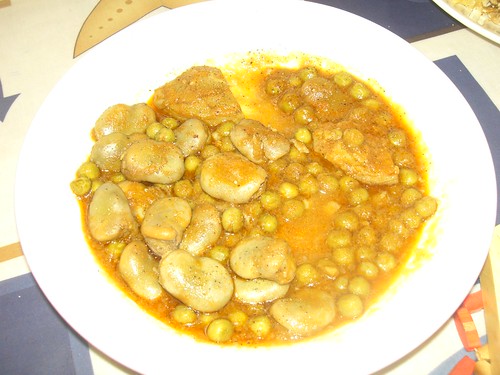

Broad bean stew in tomato sauce; the same meal can be made with an egg-and-lemon sauce, and potatoes and carrots can also be added to this dish. If the pods are very fresh and tender, they can also be eaten (cooked), otherwise they taste very bitter.
But that's pretty much it. Whether you love the nutty buttery taste of broad beans, or are simply mildly tolerant of them, choosing to add them to your meals as a token gesture of their importance to mankind and for the sake of the survival of biodiversity, you'll probably tire of them eventually, which is what happened in my family. But if broad beans are so easy to plant and grow, surely our ancestors ate them more often when there was a general lack of variety and quantity of food, most of which was home-grown or foraged. My husband's over-enthusiasm to plant them in the first place declined when he saw plate after plate of broad beans served up in traditional fashion. I'm wondering how I am going to use up the remaining 1,000 broad beans that I shelled from their pods and froze; this must have also made good animal feed in the days when all people kept animals for their food needs, but what do modern people do with broad beans in the instant gratification culture of our times?
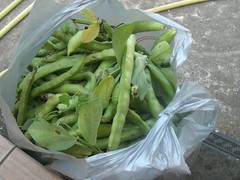
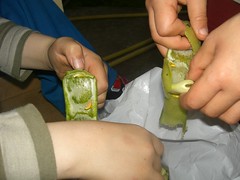
Broad beans in their pods; shelling broad beans
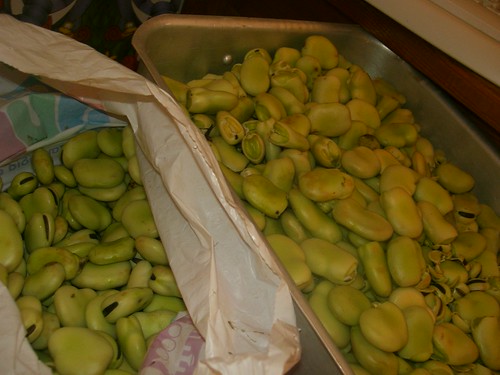
Once the broad beans are removed from the pod, they need to have the 'black eye' removed from their skin. If they are to be eaten fresh, the skin is also removed and discarded, but if they are cooked, the skin is left on. If over-cooked, broad beans become soft and mashy.
An internet search of 'broad bean' and 'fava bean', followed by country name produces an interesting wealth of fancy modern recipes, as well as the customary use of this bean in more traditional cuisines like my own. Here are some of my findings for the humble broad bean:
©All Rights Reserved/Organically cooked. No part of this blog may be reproduced and/or copied by any means without prior consent from Maria Verivaki.
Typical uses of broad beans in Crete and Greece are limited in range. There is never a copious supply of them in the market, but this is not necessarily due to their unpopularity; they grow easily (as we found out) and are often planted by the locals for their own use, so few people need to buy them. They are more popular at various periods of the year, especially during religious fasts. Freshly picked and shelled in their raw state, they are added to salads, or eaten as a meze with olives, cheese and rusks (the older male populaiton eat them like this at the kafeneion with their tsikoudia). They are also boiled (with the 'black eye' removed) and added to a warm salad of boiled leafy horta. During lenten periods, dry broad beans are soaked overnight and eaten with olives and bread, especially on days when no olive oil is permitted (during the Great Lent before Easter). Broad beans are also added to tomato- or lemon-based stews. They pair well with artichokes which are also in season at the same time.


Broad bean stew in tomato sauce; the same meal can be made with an egg-and-lemon sauce, and potatoes and carrots can also be added to this dish. If the pods are very fresh and tender, they can also be eaten (cooked), otherwise they taste very bitter.
But that's pretty much it. Whether you love the nutty buttery taste of broad beans, or are simply mildly tolerant of them, choosing to add them to your meals as a token gesture of their importance to mankind and for the sake of the survival of biodiversity, you'll probably tire of them eventually, which is what happened in my family. But if broad beans are so easy to plant and grow, surely our ancestors ate them more often when there was a general lack of variety and quantity of food, most of which was home-grown or foraged. My husband's over-enthusiasm to plant them in the first place declined when he saw plate after plate of broad beans served up in traditional fashion. I'm wondering how I am going to use up the remaining 1,000 broad beans that I shelled from their pods and froze; this must have also made good animal feed in the days when all people kept animals for their food needs, but what do modern people do with broad beans in the instant gratification culture of our times?


Broad beans in their pods; shelling broad beans

Once the broad beans are removed from the pod, they need to have the 'black eye' removed from their skin. If they are to be eaten fresh, the skin is also removed and discarded, but if they are cooked, the skin is left on. If over-cooked, broad beans become soft and mashy.
- The UK tolerates them. The broad bean is seen as a necessary part of biodiversity. It is mainly used as an addition to a main meal, notably a soup or salad.
- The US is just beginning to learn how to incorporate them more into their food, part of the slow but steady interest they are showing for real food and moving away from the fast food culture that has dominated their daily life.
- In Spain, China and other parts of Asia, fried broad beans are a favorite snack, eaten in a similar way as peanuts.
- Broad beans are Egypt's national food, made into the dish ful medames, a rich dip similar to the Greek fava; this cooking style is typical for broad beans in other African nations.
- Beans are often combined with meat in rich stews in the Mediterranean region. The broad bean makes a good alternative to potatoes and other chunky vegetables (eg peas, carrots, etc); it could easily be added to a mince chili dish instead of the usual red kidney beans.
©All Rights Reserved/Organically cooked. No part of this blog may be reproduced and/or copied by any means without prior consent from Maria Verivaki.
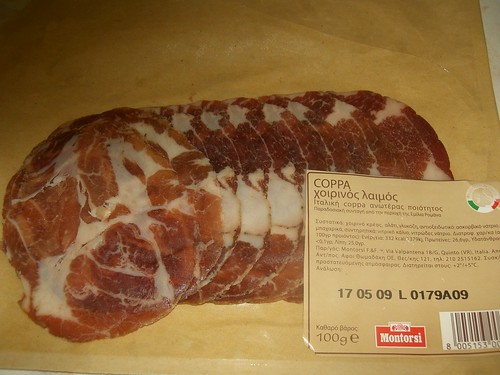
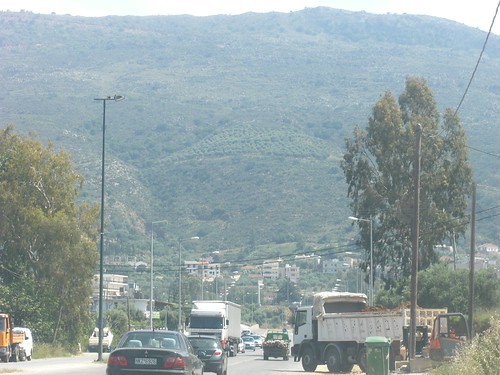


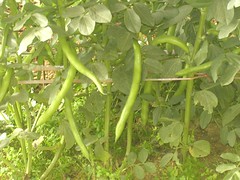
Hi there Maria, why do you have to remove the black eye from the Beans? im asking you because i am growing them for the first time as well, thank you from leonard in Sydney OZ
ReplyDeleteHi Leonard
ReplyDeleteThe black bit of the bean is said to contain all the toxins, plus it is tougher than the rest of the bean, so it isn't easy to chew through it! I don't remove it when it isn't black (when the beans aren't quite ripe, it is light green).
"...how to use up the remaining 1,000..."
ReplyDeleteI just cannot sit idly by and have all that hard work go to waste so we"ll take them off your hands. Tee hee. See you soon!
Estonians eat a lot of broad beans. This blog link below has recipes that are used up here, Estonia. I especially like the broad bean paté.
ReplyDeletehttp://nami-nami.blogspot.com
Coppa is not hard to make yourself - I have done it several times. You just need a good curing environment with a constant temperature of 15C and about 70% Relative Humidity. Something like a basement is good.
ReplyDeleteWith regards to Broad Beans - in many parts of the middle east they make Falafel with it instead of chickpeas. I've tried both the chickpea falafel and the broad bean falafel and both are very nice.
I'm not mad on broad beans, but would take a few off your hands! This last week I ate a houmous which I think was made from a green bean (maybe broad?) rather than from chick peas.
ReplyDeleteVery interesting! I haven't tried these,and I'm not sure that any stores in our town carry them yet. I'll watch for them!
ReplyDeleteHow can you know if you are sensitive to the toxin in the favas? Do you have to eat some & get sick to tell? I've never tried them but I've heard so much about them. Are they really worth all the hoopla??
ReplyDeleteHi Maria-- In Northern California these are a bellweather in the farmer markets. When they are here (as now) we know it is late spring. I think the hummus is a great idea, but will I do it? Probably not. These beans are a lot of work! I do made a pasta with the double shelled beans, spring onions, spring garlic, very good cheese and of course: olive oil from Xania! Have that with a salad and afterward, new peaches and cherries, maybe a biscotta and you are all set.
ReplyDeletePS: I got your other note and will check into it. Thanks.
I've only eaten fava beans once, in a soup. Now I know why they tasted so bitter... Thanks for the tip! I'm willing to give them another chance - if I can still find them at the market place, that is.
ReplyDeleteI accidentally ate fava beans for the first time in England, because my mother was always too afraid of the toxin. I have been in love with them ever since! BTW I just discovered copa myself. It is very tasty, but too fatty
ReplyDeleteI don't know why but my mom never really made koukia for our family and I have a hunch it's because she didn't like them!
ReplyDeleteI'm going to have to try out some dishes....your piata look fab.
Great information as always especially about the olive oil. I remember growing up my grandparents use to raise their own animals and my uncle still does. It was not uncommon to head there and see chickens or other random animals running around in a big pasture. I think I have a great appreciation for meat and animals from seeing them run around. Sad that most people do not get a chance to experience that connection.
ReplyDeleteBeans look awesome!
I love these beans as well with soupies. They go really great together.
ReplyDeleteI always learn something when I visit your blog, interesting info on olive oil. It seems to be the same with many things these days - produce more and get paid less.
ReplyDeleteThank you too for reminding me about broad beans(fava), I like them but I never see them here, I guess we'll just have to grow our own. :-)
PS. I'm glad you like the BBC Good Food site - I'm hooked on it too.
ReplyDeleteLots of great information about pigs, olive oil and fava beans, and their common thread: overabundance, whether in the national, city or home context. The last is understandable because it occurs not from deliberate practice but (at least in our case with zucchini/courgettes) from overenthusiasm. Despite recent price increases in the US, food remains relatively cheap, at least for the consumer, but is it simply because the cost is being shifted to later generations who must deal with an exhausted environment?
ReplyDeleteHi,
ReplyDeleteI have something for you on my blog. It is a gift/award. You can forward it for 5 blogger, who's kitchen or cooking you really like for some reasons, and you think/feel they are good chefs.
http://fahejesfeta.blogspot.com/2009/05/chef-lennek.html
Have a nice day!
This is a recipe of a very famous dish in Lebanon and Syria
ReplyDeleteRice with green broad bean (Riz bfoul)
Ingredients:
1 lb stew beef, chopped into small bite-sized cubes
4 tbs oil
broad green fava beans to your taste
2 cups arborio rice( you can use Basmati if you want)
generous pinch of cinnamon
generous pinch of ground allspice
small grind of black pepper
generous pinch of salt
5 cups water
Sauté the meat and let it brown. Add the beans, spices and water and bring them to a boil. Lower the heat and cover the pot. Simmer for 15 minutes. The bean and the meat should be tender. Then stir in the rice and cover the pot again. Simmer for 20 minutes, but make sure to check halfway through in case it needs more water. When it’s done, let it cool and thicken for a minute. Empty on a plate and Garnish with toasted almond and pine nuts. Then serve with plain yogurt.
Hi Maria,
ReplyDeleteplease check this website for fava bean and health problem
http://rialto.com/g6pd/
Leyla